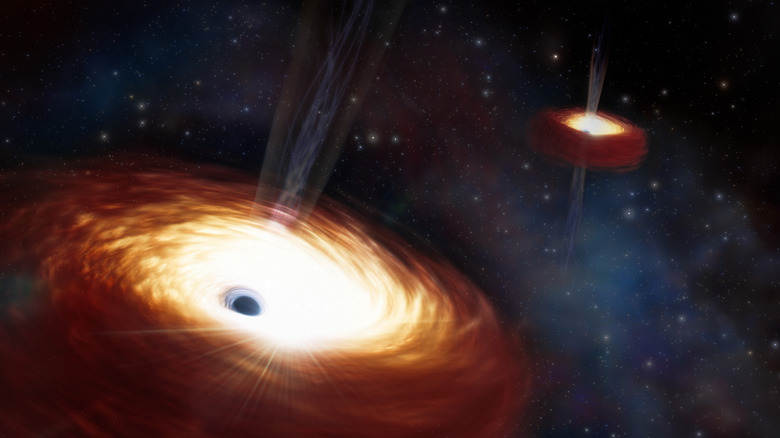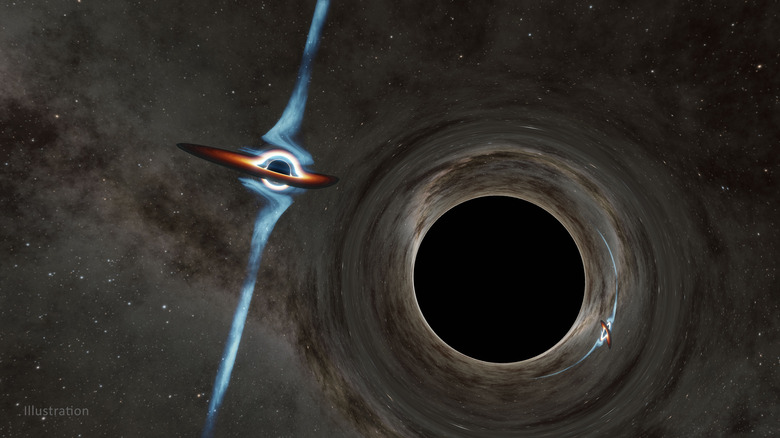These Chunky Monsters Are The Heaviest Pair Of Black Holes Ever Found
Black holes are typically thought of as lonely beasts, sucking up anything which comes too close to them — whether that is dust, planets, or even stars. But black holes can surprisingly often be found in pairs, with the two orbiting each other and often feeding off each other or even eventually plummeting into each other and colliding in a merger.
How two black holes get close enough to each other to become a binary is a big question. It seems that there are two types of binary: one for stellar-mass black holes (which weigh from five to one hundred times the mass of our sun) and one for supermassive black holes (which have a mass thousands or even millions of times that of the sun).
Scientists think that the supermassive black hole binaries probably form when two galaxies, each with a supermassive black hole at its center, merge together to form one larger galaxy. However, the formation of stellar-mass black hole binaries is a bit more complicated, and it seems to happen when one black hole gets close to another and "captures" it with its gravity.
Recently, astronomers using the Gemini North telescope were able to measure the heaviest pair of supermassive black holes found to date, and they've learned about why these monsters do — or don't — merge.
"The excellent sensitivity of [Gemini North's Gemini Multi-Object Spectrograph instrument] allowed us to map the stars' increasing velocities as one looks closer to the galaxy's center," said Roger Romani of Stanford University, co-author of the paper in The Astrophysical Journal. "With that, we were able to infer the total mass of the black holes residing there."
A long put-off merger
The mass of the pair of supermassive black holes located in the elliptical galaxy B2 0402+379 is calculated to be a whopping 28 billion times the mass of the sun. With this enormous mass, the two black holes are also shockingly close together, with just 24 light-years between them.
With so much mass and so little space, the two would be expected to merge and create one even larger black hole, but that doesn't seem to have happened yet. Scientists estimate that the two have held at this close distance for over three billion years.
It may be that the large mass of the black holes is what is preventing them from merging. It seems that the black holes got so big because they are themselves the results of previous galaxy mergers. Each one could be the result of multiple different smaller black holes being pulled together, allowing the black holes to grow over time.
But when supermassive black holes merge, they don't crash straight into each other. Instead, they generally skim past each other before slingshotting back around, moving past each other in a series of close calls. As they do this dance, they gradually lose energy until they settle into a stable orbit around each other.
Why these two didn't merge
As these two supermassive black holes are so massive, they must have needed the pull of huge numbers of stars to slow them down, and as they slowed, they would have pushed out almost all the dust and gas in the center of the galaxy. That means there would be very little matter for them to feed on, and any further action would have stalled out.
"Normally, it seems that galaxies with lighter black hole pairs have enough stars and mass to drive the two together quickly," said Roger Romani. "Since this pair is so heavy, it required lots of stars and gas to get the job done. But the binary has scoured the central galaxy of such matter, leaving it stalled and accessible for our study."
Researchers have been making the most of this rare opportunity to see supermassive black holes just before they merge, and scientists are still debating whether the two will merge eventually.
To learn more about whether they will merge in the end, the researchers say they want to perform more investigations into this galaxy, looking at how much material is available in its center for the pair to feed on.
"We're looking forward to follow-up investigations of B2 0402+379's core where we'll look at how much gas is present," said Tirth Surti of Stanford, lead author on the paper. "This should give us more insight into whether the supermassive black holes can eventually merge or if they will stay stranded as a binary."

